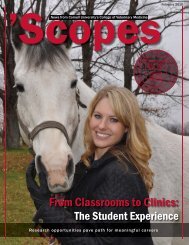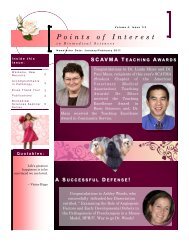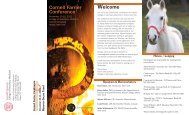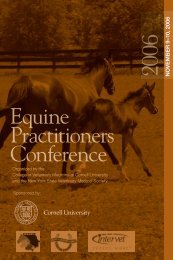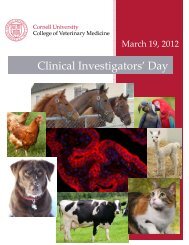2010 (PDF) - The College of Veterinary Medicine at Cornell University
2010 (PDF) - The College of Veterinary Medicine at Cornell University
2010 (PDF) - The College of Veterinary Medicine at Cornell University
You also want an ePaper? Increase the reach of your titles
YUMPU automatically turns print PDFs into web optimized ePapers that Google loves.
Sanne Hugen, Universiteit Utrecht, Molecular Biology<br />
Investig<strong>at</strong>ing DNA damage response activ<strong>at</strong>ion in testicular germ cell tumors <strong>of</strong> the<br />
mouse.<br />
<strong>The</strong> Leadership Program enabled me to think about, consider and weigh different<br />
career opportunities one has as a veterinarian. It also enabled me to meet gre<strong>at</strong><br />
people and to become personally involved with exciting research. This combin<strong>at</strong>ion<br />
<strong>of</strong> experiences and the insights they provided was exactly wh<strong>at</strong> I hoped to get out <strong>of</strong><br />
the program.<br />
My project in the Weiss lab, under the guidance <strong>of</strong> Dr. Amy Lyndaker was to<br />
investig<strong>at</strong>e the DNA damage in a mouse model <strong>of</strong> testicular germ cell tumors. In<br />
contrast to most tumors, testicular germ cell tumors (TGCT) occur <strong>at</strong> a very young<br />
age in men and respond well to tre<strong>at</strong>ment. <strong>The</strong> l<strong>at</strong>ter likely is rel<strong>at</strong>ed to the lack <strong>of</strong><br />
constitutive activ<strong>at</strong>ed DDR and absence <strong>of</strong> mut<strong>at</strong>ed DNA damage response genes<br />
in such tumors. <strong>The</strong> aim <strong>of</strong> my project was to examine if the DDR is still functional<br />
and can be activ<strong>at</strong>ed by DNA damaging agents. We performed western blot analysis<br />
<strong>of</strong> DDR proteins on cell cultures tre<strong>at</strong>ed with the DNA damaging agents 4NQO or<br />
cispl<strong>at</strong>in and found th<strong>at</strong> the DDR is intact in the tumor cells. Because there is still<br />
a gre<strong>at</strong> need for better animal models on TGCTs, a second part <strong>of</strong> my project focused on the gener<strong>at</strong>ion <strong>of</strong> a new<br />
mouse model.<br />
My time in the lab provided me fantastic opportunity to learn new techniques and to gain a valuable perspective on<br />
research. I would like to thank all the gre<strong>at</strong> people in the lab for their help and the gre<strong>at</strong> <strong>at</strong>mosphere they cre<strong>at</strong>ed.<br />
Marie Killerby, Cambridge <strong>University</strong> (Selwyn <strong>College</strong>), Virology<br />
Host specifi c receptors for canine and equine infl uenza viruses<br />
Studying veterinary medicine has given me an appreci<strong>at</strong>ion <strong>of</strong> multiple fi elds <strong>of</strong><br />
compar<strong>at</strong>ive biological investig<strong>at</strong>ion. My studies sparked an interest in scientifi c<br />
research. I applied to the <strong>Cornell</strong> Leadership Program hoping to gain my fi rst hands<br />
on experience <strong>of</strong> labor<strong>at</strong>ory research. I was assigned a project working with canine<br />
infl uenza virus, which I considered a fantastic opportunity given the importance <strong>of</strong><br />
infl uenza viruses to both animal and human health.<br />
My research project involved looking <strong>at</strong> host cell receptors for infl uenza viruses,<br />
sialic acids, devising staining protocols to mark sialic acids and <strong>at</strong>tempting to adjust<br />
the type <strong>of</strong> sialic acid present on canine cells. It is hoped th<strong>at</strong> these tools can then<br />
be used to see differences in the binding <strong>of</strong> canine and equine infl uenza viruses<br />
to cells with different levels <strong>of</strong> sialic acid expression. This would enable one to<br />
demonstr<strong>at</strong>e whether mut<strong>at</strong>ions in the haemagglutinin gene from equine infl uenza<br />
to canine infl uenza virus cause a change in the binding <strong>of</strong> infl uenza virus to host<br />
cell receptors.<br />
I have thoroughly enjoyed the leadership program this summer. I found the<br />
modules invaluable in broadening my knowledge <strong>of</strong> careers available to veterinarians. My research project also<br />
was a fantastic experience, enabling me to learn a huge amount not only about the specifi cs <strong>of</strong> canine and equine<br />
infl uenza viruses but also how to approach projects and work through the challenges and problems one comes<br />
across. I would like to thank Dr. Parrish and everyone in the Parrish Lab, particularly Oz and Jess, for allowing me to<br />
work with them this summer.<br />
To prepare tomorrow’s scientists and public health pr<strong>of</strong>essionals<br />
29



